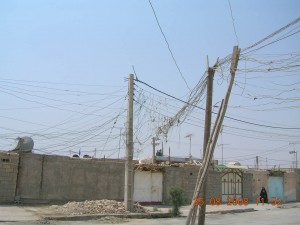Inter-harmonics, specially first and second order inter-harmonics, in modulation with fundamental frequency, 2nd order harmonic, or also (with lower probability) higher order harmonics, can produce intensive flicker.
One of the main sources of inter-harmonics is VSD (Variable Speed Drive). Specially in places where lighting loads are powered by the UPS, due to the low short circuit level of DC bus, inter-harmonics have a high potential to generate flicker.
Based on “William Stanley Jevons’ theory” , this problem also can be theorized as follows:
1 -Increasing electricity consumption prices leads to using more and more energy saving technologies such as VSDs.
2 – Using VSDs leads to increasing of inter-harmonics and also flicker.
3 – Flicker leads to Increased eye diseases.
4 – Increased eye diseases leads to increased treatment costs.
So costs will be balanced again near the previous point.
Astronomical clocks, unlike photocells, control street lighting based on time of sunrise and sunset which is calculated based on latitude and longitude of the street. This equipment has a main advantage in respect to photocell which is reducing on-time and off-time errors caused by contamination of the opaque cover of the photocell.
In inspecting one of the pilot projects, accidentally i turned my thermal imaging camera on one of these astronomical clocks (which was installed in the distribution substation) and saw the below image!
This picture reminds me a report that has presented in a loss reduction conference in Madagascar island . In this report, noted that after two years of executing loss reduction projects in an African country , studies show that energy losses increased 1% !!!!!!!

Generalized theory of electrical machines provides a common framework for studying, modelling, simulating and understanding the behavior of all electrical machines. In this theory, by using Kron’s primitive hypothesis machine we can simulate all kind of machines. This model is a dependent model to the reference frame that will be selected for studies. Different reference frames can be chosen depending to case. For example, stationary or moving common frames (with different speeds) are common . Here i introduce 8 video lectures for reviewing the generalized theory of electrical machines. The lecturer is Professor S.P.Das from Indian institute of technology Kanppur.
Lecture 1 : Introduction
Lecture 2 : Kron’s Primitive Machine
Lecture 3 : Modelling of Dc Machines
Lecture 4 : Modelling of Induction Machines in ABC model
Lecture 5 : Transformation from ABC to dqo
Lecture 6 : Modelling of Induction Machines in dqo model and reference frame theory
Lecture 7 : Modelling of Synchronous Machines (1)
Lecture 8 : Modelling of Synchronous Machines (2)
Electrical Machines, Generalized theory, Generalized Theory of Electrical Machines, Kron's Primitive Machine, Modelling of Dc Machines, Modelling of Induction Machines, Modelling of Induction Machines in ABC model, Modelling of Synchronous Machines, reference frame theory, Transformation from ABC to dqo, video lectures
more...
Schneider Electric, announced an expanded curriculum, additional languages and education credits, for its vendor-neutral, online educational community, Energy University™. Designed to provide the fundamentals needed to implement successful energy efficient solutions, Energy University has seen more than 21,000 registered users since its launch in June 2009. Twenty-one new courses have been added to the curriculum in 2010 to increase the educational offering to 34. Courses are available in multiple languages – English, German, and Spanish, with French, Italian, Brazilian Portuguese, and Russian launching later this year. Additionally, Energy University has now launched a fully translated version of the site in Chinese, making this the first online energy efficiency program available in that country.
(continue reading…)
Visual display units technology (VDUs) are progressing with an incredible speed. From the time that man could transmit voice over the phone virtually, one hundred and thirty years have been passed. Now, human counts for transmitting of his virtual image. The image that does not make any sense of being unreal. Thanks to the advanced technology of smart and three-dimensional screens, it seems that in less than one decade it will very hard to distinguish real humans from their virtual images (or virtual presence).
Imagine a world where instead of actual attendance at a meeting in a far city, send your virtual presence to there …. A world with less risks, less difficulties and higher efficiency …
Imagine a world where centralized hospitals changes to a large number of reception rooms with an intelligent and virtual examination system which are equipped with advanced laboratory equipments and will be operated with only one technician.
Doctors examine patients through virtual presence and different types of images, such as MRI, Sonography, X-ray and … will be investigated by virtual presence of several specialists.
In this way, consecutive visits of patients to different doctors and hearing opposing views can be avoided.
Thanks to the high resolution (HD) and large three-dimensional screens, the human brain can not distinguish a virtual image from its real. World that already have experienced it through the mirage phenomenon …
Imagine a world where you are surrounded by the masses of smart particles at the nanoscale. This smart particles are a series of wireless sensors that gather various information about the world, and transmit it to the control center.
Each of these particles contain one or more sensors, a wireless telecommunications system, a rechargeable energy source which is augmented by the radio waves and an identification code (for fixed particles) or a GPS system (for moving particles). Such a structure is called Smart Dust. Consider, for example, smart dust that spread across the highway and transmit a variety of information such as light intensity and traffic to the control center. By Benefiting from this system, electricity utilities can quickly identify a faulty bulb and replace it. Or light density over road can be set depending on traffic.
As another example, smart sensors, which are scattered in a huge multi-storey car park can detect empty parking and send information to the control center. So, each car can be led to nearest empty parking by turning on pilot LED lights.
Or smart dust that spread over a bridge, can transmit oxidation rate, PH of water, corrosion rate and … to the control center.
Such a world is called a smart dust based world. In this world, doctors can control performance of critical parts of patient’s bodies by prescription of breathing or drinking the air or water which contains smart dust. This technology is the start of a new era of human control over the surroundings and an unlimited number of ideas to facilitate human life. Facilities that one day humans will be difficult to imagine life without it.
May targeted subsidies in electricity sector result more non-technical losses?




